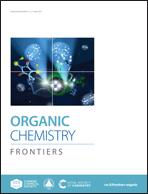Mechanistic studies on nickel-catalyzed enantioselective [3 + 2] annulation for γ-butenolide synthesis via C–C activation of diarylcyclopropenones†
Abstract
Highly efficient Ni-catalyzed C–C activation of cyclopropenones en route to enantioselective [3 + 2] annulation with α-CF3 enones or 1,2-diones has been realized toward the efficient synthesis of γ-butenolides. Mechanistic aspects such as exceptionally high efficiency, unusual enone carbonyl-participated chemoselectivity, and enantioselective control have been elucidated by an integrated experimental and computational approach. DFT studies revealed a key step of oxidative addition of cyclopropenone to enone-ligated nickel, followed by an unusual endo-type 4,1-insertion to give a tethered allyl–Ni(II) intermediate. Stereo-determining C–C reductive elimination of this allyl species affords the [3 + 2] annulation product. Computational studies also suggested that coordination of the olefin unit of enone dramatically decreases the activation barrier of subsequent C–C oxidative addition of cyclopropenone. Moreover, a three-coordinate Ni(0) olefin complex (confirmed by X-ray crystallography) was experimentally and theoretically identified as the resting state of the catalyst.
![Graphical abstract: Mechanistic studies on nickel-catalyzed enantioselective [3 + 2] annulation for γ-butenolide synthesis via C–C activation of diarylcyclopropenones](/en/Image/Get?imageInfo.ImageType=GA&imageInfo.ImageIdentifier.ManuscriptID=D1QO00322D&imageInfo.ImageIdentifier.Year=2021)


 Please wait while we load your content...
Please wait while we load your content...